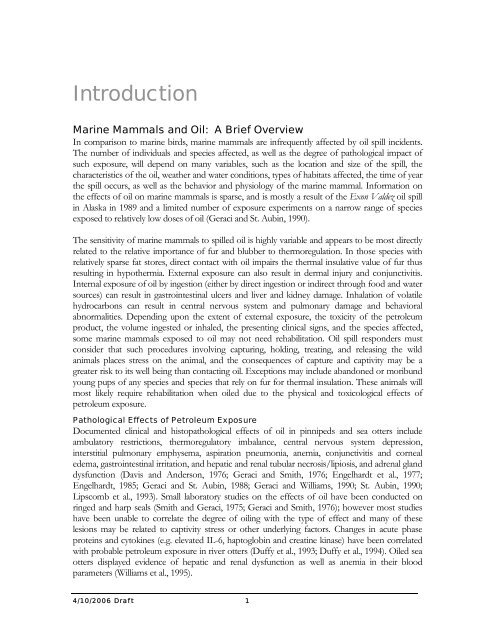Volume III, Appendices EM - National Marine Fisheries Service ...
Volume III, Appendices EM - National Marine Fisheries Service ...
Volume III, Appendices EM - National Marine Fisheries Service ...
Create successful ePaper yourself
Turn your PDF publications into a flip-book with our unique Google optimized e-Paper software.
Introduction<br />
<strong>Marine</strong> Mammals and Oil: A Brief Overview<br />
In comparison to marine birds, marine mammals are infrequently affected by oil spill incidents.<br />
The number of individuals and species affected, as well as the degree of pathological impact of<br />
such exposure, will depend on many variables, such as the location and size of the spill, the<br />
characteristics of the oil, weather and water conditions, types of habitats affected, the time of year<br />
the spill occurs, as well as the behavior and physiology of the marine mammal. Information on<br />
the effects of oil on marine mammals is sparse, and is mostly a result of the Exon Valdez oil spill<br />
in Alaska in 1989 and a limited number of exposure experiments on a narrow range of species<br />
exposed to relatively low doses of oil (Geraci and St. Aubin, 1990).<br />
The sensitivity of marine mammals to spilled oil is highly variable and appears to be most directly<br />
related to the relative importance of fur and blubber to thermoregulation. In those species with<br />
relatively sparse fat stores, direct contact with oil impairs the thermal insulative value of fur thus<br />
resulting in hypothermia. External exposure can also result in dermal injury and conjunctivitis.<br />
Internal exposure of oil by ingestion (either by direct ingestion or indirect through food and water<br />
sources) can result in gastrointestinal ulcers and liver and kidney damage. Inhalation of volatile<br />
hydrocarbons can result in central nervous system and pulmonary damage and behavioral<br />
abnormalities. Depending upon the extent of external exposure, the toxicity of the petroleum<br />
product, the volume ingested or inhaled, the presenting clinical signs, and the species affected,<br />
some marine mammals exposed to oil may not need rehabilitation. Oil spill responders must<br />
consider that such procedures involving capturing, holding, treating, and releasing the wild<br />
animals places stress on the animal, and the consequences of capture and captivity may be a<br />
greater risk to its well being than contacting oil. Exceptions may include abandoned or moribund<br />
young pups of any species and species that rely on fur for thermal insulation. These animals will<br />
most likely require rehabilitation when oiled due to the physical and toxicological effects of<br />
petroleum exposure.<br />
Pathological Effects of Petroleum Exposure<br />
Documented clinical and histopathological effects of oil in pinnipeds and sea otters include<br />
ambulatory restrictions, thermoregulatory imbalance, central nervous system depression,<br />
interstitial pulmonary emphysema, aspiration pneumonia, anemia, conjunctivitis and corneal<br />
edema, gastrointestinal irritation, and hepatic and renal tubular necrosis/lipiosis, and adrenal gland<br />
dysfunction (Davis and Anderson, 1976; Geraci and Smith, 1976; Engelhardt et al., 1977;<br />
Engelhardt, 1985; Geraci and St. Aubin, 1988; Geraci and Williams, 1990; St. Aubin, 1990;<br />
Lipscomb et al., 1993). Small laboratory studies on the effects of oil have been conducted on<br />
ringed and harp seals (Smith and Geraci, 1975; Geraci and Smith, 1976); however most studies<br />
have been unable to correlate the degree of oiling with the type of effect and many of these<br />
lesions may be related to captivity stress or other underlying factors. Changes in acute phase<br />
proteins and cytokines (e.g. elevated IL-6, haptoglobin and creatine kinase) have been correlated<br />
with probable petroleum exposure in river otters (Duffy et al., 1993; Duffy et al., 1994). Oiled sea<br />
otters displayed evidence of hepatic and renal dysfunction as well as anemia in their blood<br />
parameters (Williams et al., 1995).<br />
4/10/2006 Draf t 1
















